Tetrode
A tetrode is a vacuum tube (called valve in British English) having four active electrodes. The four electrodes in order from the centre are: a thermionic cathode, first and second grids and a plate. There are several varieties of tetrodes, the most common being the screen-grid tube and the beam tetrode. In screen-grid tubes and beam tetrodes, the first grid is the control grid and the second grid is the screen grid.[1] In other tetrodes one of the grids is a control grid, while the other may have a variety of functions.
The tetrode was developed in the 1920s by adding an additional grid to the first amplifying vacuum tube, the triode, to correct deficiencies in the triode. During the period 1913 to 1927, three distinct types of tetrode valves appeared. All had a normal control grid whose function was to act as a primary control for current passing through the tube, but they differed according to the intended function of the other grid. In order of historical appearance these are: the space-charge grid tube, the bi-grid valve, and the screen-grid tube. The last of these appeared in two distinct variants with different areas of application: the screen-grid valve proper, which was used for medium-frequency, small signal amplification, and the beam tetrode which appeared later, and was used for audio or radio-frequency power amplification. The former was quickly superseded by the rf pentode, while the latter was initially developed as an alternative to the pentode as an audio power amplifying device. The beam tetrode was also developed as a high power radio transmitting tube.
Tetrodes were widely used in many consumer electronic devices such as radios, televisions, and audio systems until transistors replaced valves in the 1960s and 70s. Beam tetrodes have remained in use until quite recently in power applications such as audio amplifiers and radio transmitters.
How it works
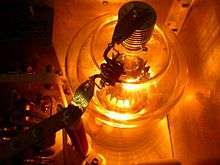
The tetrode functions in a similar way to the triode, from which it was developed. A current through the heater or filament heats the cathode, which causes it to emit electrons by thermionic emission. A positive voltage is applied between the plate and cathode, causing a flow of electrons from the cathode to plate through the two grids. A varying voltage applied to the control grid can control this current, causing variations in the plate current. With a resistive or other load in the plate circuit, the varying current will result in a varying voltage at the plate. With proper biasing, this voltage will be an amplified (but inverted) version of the AC voltage applied to the control grid, thus the tetrode can provide voltage gain. In the tetrode, the function of the other grid varies according to the type of tetrode; this is discussed below.
Space charge grid tube
The space charge grid tube was the first type of tetrode to appear. In the course of his research into the action of the "audion" triode tube of Lee de Forest, Irving Langmuir found that the action of the heated thermionic cathode was to create a space charge, or cloud of electrons, around the cathode. This cloud acted as a virtual cathode. With low applied anode voltage, many of the electrons in the space charge returned to the cathode, and did not contribute to the anode current; only those at its outer limit would be affected by the electric field due to the anode, and would be accelerated towards it. However, if a grid bearing a low positive applied potential (about 10V) were inserted between the cathode and the control grid, the space charge could be made to extend further away from the cathode. This had two advantageous effects, both related to the influence of the electric fields of the other electrodes (anode and control grid) on the electrons of the space charge. Firstly, a significant increase in anode current could be achieved with low anode voltage; the valve could be made to work well with lower applied anode voltage. Secondly the transconductance (rate of change of anode current with respect to control grid voltage) of the tube was increased. The latter effect was particularly importance since it increased the voltage gain available from the valve. [2] [3][4]
Space-charge valves remained useful devices throughout the valve era, and were used in applications such as car radios operating directly from a 12V supply, where only a low anode voltage was available. The same principle was applied to other types of multi-grid tubes such as pentodes. As an example, the Sylvania 12K5 is described as "a tetrode designed for space-charge operation. It is intended for service as a power amplifier driver where the potentials are obtained directly from a 12V automobile battery." The space-charge grid was operated at +12V, the same as the anode supply voltage. [5]
Another important application of the space-charge tetrode was as an electrometer tube for detecting and measuring extremely small currents. For example, the General Electric FP54 was described as a "space-charge grid tube ... designed to have a very high input impedance and a very low grid current. It is designed particularly for amplification of direct currents smaller than about 10-9
amperes, and has been found capable of measuring currents as small as 5 x 10-18
amperes. It has a current amplification factor of 250,000, and operates with an anode voltage of 12v, and space-charge grid voltage of +4V."
[6] The mechanism by which the space-charge grid lowers control-grid current in an electrometer tetrode is that it prevents positive ions originating in the cathode from reaching the control grid. [7]
Note that when a space-charge grid is added to a triode, the first grid in the resulting tetrode is the space-charge grid, and the second grid is the control grid.
Bi-grid valve
In the bi-grid type of tetrode, both grids are intended to carry electrical signals, so both are control grids. The first example to appear in Britain was the Marconi-Osram FE1, which was designed by H.J. Round, and became available in 1920.[4] The tube was intended to be used in a reflex circuit (for example the single-valve ship receiver Type 91[8])where the same valve performed the multiple functions of rf amplifier, af amplifier, and diode detector. The rf signal was applied to one control grid, and the af signal to the other. This type of tetrode was used in many imaginative ways in the period before the appearance of the screen-grid valve revolutionised receiver design.[9][10]
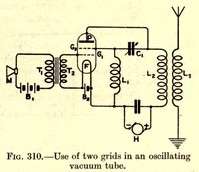
One application is shown in the illustration. This is recognisable as an AM telephony transmitter in which the second grid and the anode form a power oscillator, and the first grid acts as a modulating electrode. The anode current in the valve, and hence the RF output amplitude, is modulated by the voltage on G1, which is derived from a carbon microphone. [11] A tube of this type could also be used as a direct conversion CW receiver. Here the valve oscillates as a consequence of coupling between the first grid and the anode, while the second grid is coupled to the antenna. The AF beat frequency is audible in the headphones. The valve acts as a self-oscillating product detector. [12] Another, very similar application of the bi-grid valve was as a self oscillating frequency mixer in early superhet receivers[13] One control grid carried the incoming rf signal, while the other was connected into an oscillator circuit which generated the local oscillation within the same valve. Since the anode current of the bi-grid valve was proportional both to the signal on the first grid, and also to the oscillator voltage on the second grid, the required multiplication of the two signals was achieved, and the intermediate frequency signal appeared in an appropriately tuned circuit connected to the anode. In all of the applications mentioned, the bi-grid tetrode acted as an analogue multiplier (analog multiplier) which multiplied together the signals applied to the two grids.
The super-sonic heterodyne (superhet) receiver principle was invented in France by Lucien Levy in 1917[14] (p 66), though credit is usually also given to Edwin Armstrong. The original reason for the invention of the superhet was that before the appearance of the screen-grid valve, there was no type of valve which could give good gain at radio frequencies (i.e. frequencies much above 100 kHz), so a technique was applied whereby the incoming rf signal was "mixed" (i.e. multiplied) with a locally generated oscillatory voltage (the local oscillator) so as to produce a beat frequency at the significantly lower frequency of about 30 kHz. This represented the incoming signal in all important respects, but at a lower frequency, at which it could be successfully amplified by a multistage tuned triode amplifier before being applied to the detector.[15] This was a complicated technique. It went out of use when screen-grid valves appeared which could act as satisfactory rf amplifiers capable of amplifying the incoming signal without lowering its frequency (see Screen grid valve, below). Superhet receivers reappeared in the early 1930s when, because of the proliferation of transmitting stations, their greater selectivity became an important advantage; almost all receivers operate on this principle today, albeit with a higher if frequency.
Screen grid valve
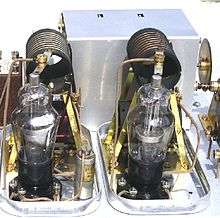

In the screen grid class of tetrode, the main function of the second grid is to act as an electrostatic screen between the anode and the control grid (i.e. the first grid) in order to reduce the internal capacitance between control grid and anode. The first true screen-grid valve, with a screen grid designed for this purpose, was patented by Hiroshi Ando in 1919, and the first practical versions were built by N. H. Williams and Albert Hull at General Electric and Bernard Tellegen at Phillips in 1926.[16]
This type of tetrode was developed to correct deficiencies in the triode tube which became apparent when attempts were made to use triodes as small-signal radio-frequency amplifiers. In the triode, the control grid was next to the plate. Capacitance between these two electrodes caused instability and oscillation when both anode and grid were connected into tuned resonant circuits, as was the case in early radios, or in any application where the anode circuit presented an inductive reactive load to the valve.[17] Oscillation could only be avoided by using very small stage gain at frequencies above about 100 kHz, and at frequencies above 1 MHz, triodes are virtually useless in tuned amplifiers in which both anode and grid circuits are tuned to the same frequency. A second advantage of the tetrode, which also arose from reduced anode-grid capacitance, was that, when the anode voltage was in a certain range, changing its value had much less effect on the anode current than was the case with triodes. This corresponds to an increased anode slope resistance, and allowed much higher voltage gain by permitting a larger external load resistance. At the time of the introduction of screen-grid valves (around 1927) a typical small triode used for small-signal amplification had an anode slope resistance of 20kOhms or less, and a grid-anode capacitance of 1 to 5pF, while the corresponding figures for a typical screen grid valve were 1MOhm and 0.004pF - in some cases much less capacitance.[18]
Screen-grid valves were capable of greater voltage gain and higher frequency capability than triodes, and permitted the development of the first true RF amplifiers in the MF and HF frequency ranges in radio equipment. They were commonly used as the first stage of radio-frequency amplification in domestic radio receivers in the period 1927 to 1930, after which they were superseded in this application by RF pentodes. Triodes were ill-suited to this type of application on account of their relatively high anode-grid capacitance and low anode resistance.
In normal operation the screen grid is connected to a positive DC voltage slightly less than the plate voltage, and bypassed to the cathode with a capacitor, so it was at AC ground. To take full advantage of the very low internal grid-anode capacitance, the valve must be used in circuits in which the shielding between anode and grid is continued externally. In the case illustrated (S625), the valve was intended to be inserted into a hole in an external, grounded, sheet-metal shield aligned to correspond with the position of the internal screen-grid. The input, or control-grid circuit was on one side of the shield, while the anode, or output circuit was on the other. In the case of the Osram Music Magnet, each entire stage of the 2-stage rf amplifier, as well as the tuned detector stage, was enclosed in an individual large aluminium screening box. These boxes have been removed in the illustration, but the up-turned edges of the bases of the boxes can be seen.
Anode characteristic of screen-grid valves
The reason for the limited applicability of the screen-grid valve, and its rapid replacement by the RF pentode (introduced around 1930) was the peculiar anode characteristic (i.e. variation of anode current with respect to anode voltage) of the former type of tube.

In normal applications, the anode voltage was about 150V, while that of the screen-grid was about 60V (Thrower p 183).[4] As the screen grid is positive with respect to the cathode, it collects a certain fraction (perhaps a quarter) of the electrons which would otherwise pass from the grid region to the anode. This causes current to flow in the screen grid circuit. Usually, the screen current due to this cause is small, and of little interest. However, if the anode voltage should be below that of the screen, the screen grid can also collect secondary electrons ejected from the anode by the impact of the energetic primary electrons. Both effects tend to reduce the anode current. If the anode voltage is increased from a low value, with the screen grid at its normal operating voltage (60V, say) the anode current initially increases rapidly because more of those electrons which pass through the screen-grid are collected by the anode rather than passing back to the screen grid. This part of the tetrode anode characteristic resembles the corresponding part of that of a triode or pentode. However, when the anode voltage is increased further, the electrons arriving at the anode have sufficient energy to cause copious secondary emission, and many of these secondary electrons will be captured by the screen, which is at a higher positive voltage than the anode. This causes the anode current to fall rather than increase when the anode voltage is increased. In some cases the anode current can actually become negative (current flows out of the anode); this is possible since each primary electron may produce more than one secondary. Falling positive anode current accompanied by rising anode voltage gives the anode characteristic a region of negative slope, and this corresponds to a negative resistance which can cause instability in certain circuits. In a higher range of anode voltage, the anode voltage sufficiently exceeds that of the screen for an increasing proportion of the secondary electrons to be attracted back to the anode, so the anode current increases once more, and the slope of the anode characteristic becomes positive again. In a yet higher range of anode voltages, the anode current becomes substantially constant, since all of the secondary electrons now return to the anode, and the main control of current through the tube is the voltage of the control grid. This is the normal operating mode of the tube.[19]

The anode characteristic of a screen-grid valve is thus quite unlike that of a triode. It includes a range of anode voltages, where the anode voltage is less than that of the screen grid, in which there is a distinctive negative resistance characteristic, sometimes called "tetrode kink". This is usually undesirable, although it can be exploited as in the dynatron oscillator (Eastman, p 431).[3] The approximately constant-current region of low slope at high anode voltage is also a distinctive characteristic of the tetrode. This is highly desirable, since it corresponds to a high source resistance in the anode circuit, and greatly enhances the voltage gain which the device can produce. Early screen-grid valves had amplification factors (i.e. the product of transconductance and anode slope resistance) ten times that of comparable small-signal triodes.[20] The high anode resistance (i.e. low slope) in the normal operating range is a consequence of the electrostatic shielding action of the screen grid, since it prevents the electric field due to the anode from penetrating to the control grid region, where it might otherwise influence the passage of electrons, increasing the electron current when the anode voltage is high, reducing it when low.

In practice the negative-resistance kink of the anode characteristic limits the usefulness of the screen-grid valve to applications where only small signals are amplified, so that the variations in anode voltage are also correspondingly small, and the operating conditions never depart from the region of high positive impedance (low positive slope) at large anode voltage. The secondary emission can be prevented from contributing to the screen current (and thus detracting from the anode current) by adding a suppressor grid, making a pentode, or beam plates to make a beam tetrode/kinkless tetrode, which can be used in power amplifiers where the variations of anode voltage, due to the presence of a large signal voltage, are much greater. The anode characteristics of these tubes are very similar to pentodes. In both cases the anode current rises rapidly to an approximately constant value when the anode voltage rises to as little as a few tens of volts, and the region of high positive anode resistance (low slope) extends from this low value up to the maximum anode voltage which could be several hundred volts or more.
The negative resistance operating region of the tetrode is exploited in the dynatron oscillator, which is an example of a negative resistance oscillator. (Eastman, p431)[3]
Beam tetrode
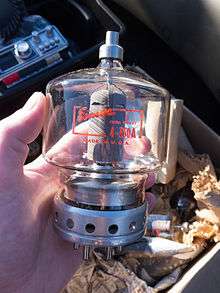

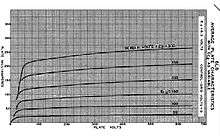
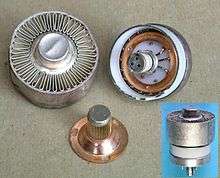
The high value of the anode slope resistance of tetrodes (mentioned above) makes them capable of high voltage and power gain, and is also potentially a cause of high anode efficiency which, if it could be exploited, would make tetrodes superior to triodes as power amplifying devices in applications such as audio power amplifiers, and the output stages of radio transmitters. For a triode power amplifier working with a transformer or inductive load in Class A, the maximum theoretical efficiency is 25%. This low figure is in part a consequence of the low anode slope impedance (Ra) of this type of tube; the low value of a triode Ra is almost always much less than the optimal anode load impedance in a power amplifier. For a pentode or tetrode, however, Ra is usually sufficiently high for the optimal load impedance to be achieved, and under these circumstances the maximum theoretical efficiency rises to 50%.[21] This gives these latter types of tube an important practical advantage over triodes, which is of particular value when high power outputs are required.
However, the tetrode kink limits the permissible variation of anode voltage, and restricts the use of screen-grid valves to small-signal applications. The suppressor grid of the pentode eliminates the kink in the anode characteristic by preventing secondary electrons, which originate in the anode, from reaching the screen grid, and thus permits a wider excursion of anode voltage, as is required for power amplification. The same effect can be produced in the case of a tetrode by introducing two modifications. Firstly, the wires of the screen grid are aligned with those of the control grid so that the former lie in the electron 'shadow' created by the latter. This reduces the screen grid current, thereby giving greater efficiency, and also concentrates the electrons into dense beams in the space between the screen grid and the anode. The intense negative space charge of these beams prevents secondary electrons from the anode from reaching the screen grid, thus eliminated the tetrode kink. Secondly, in small valves whose electrode structure is supported in the conventional way with vertical wire rods and mica spacers, it was found to be necessary to introduce sheet-metal beam-forming electrodes between the screen grid and the anode. The purpose of these beam-plates is to constrain the electron beams into parts of the electrode system which are sections of a cylinder.[22] (See sectional view, right). Successful creation of the electron beam between screen grid and anode required for a kinkless anode characteristic depends on the details of the geometry of the electrode structure of the beam tetrode. In the cases where the electrodes have complete cylindrical symmetry, a kinkless characteristic can be achieved without the need for beam-plates, alignment of the screen grid wires with those of the control grid being sufficient. This form of construction is usually adopted in the larger tubes with an anode power rating of 100W or more. The Eimac 4CX250B (rated at 250W anode dissipation) is an example of this class of beam tetrode. Note that a radically different approach is taken to the design of the support system for the electrodes in these types (see illustration). The 4CX250B is described by its manufacturer as a 'radial beam tetrode', drawing attention to the symmetry of its electrode system.
The overall effect of the original developments was to produce a highly effective power amplifier tube, whose anode characteristic is very much like that of a pentode, but which has greater efficiency as a result of reduced screen current. A further bonus was that third harmonic distortion was much reduced relative to a comparable pentode (Terman pp 198–9). [19] Beam tetrode audio power output valves were introduced in 1937, and quickly replaced conventional pentodes in this application. Later developments produced beam power tubes which were capable of high-power output at frequencies extending into the UHF region.
The beam tetrode was invented in Britain by two EMI engineers, Cabot Bull and Sidney Rodda, as an attempt to circumvent the power pentode, whose patent was owned by Philips. It was patented in 1933.[23] Although the beam-plates (when present) could be counted as a fifth electrode (as in a pentode), this type of tube is nevertheless classified as a tetrode, perhaps to underline the difference in principle from that employed in true pentodes, which rely upon the effect of a suppressor grid. Beam tetrodes were widely used as audio power amplifying tubes in consumer and industrial electronic equipment such as radios and televisions until the 1960s when they were replaced by transistors. Their main use now is in high power industrial applications such as radio transmitters. Low power consumer beam tetrodes are still used in a few legacy and specialty vacuum tube audio power amplifier devices such as tube guitar amplifiers; the KT66 and KT88 are popular examples in audio equipment, while QY4-400 is an example having 400W anode dissipation, capable of applications in radio transmitters up to 100 MHz. The 4CX250B, mentioned above can be operated at full 250W anode dissipation up to 500 MHz. Many other types abound.
Critical-distance tetrode
An alternative approach to the problem of eliminating the tetrode kink was introduced by Hivac in 1935. It was found by J.H Owen Harries that if the separation of the anode from the screen grid were varied, a critical separation could be found (about 3 cm) where the kink in the tetrode's anode characteristic disappeared, and the amplification of the valve became particularly distortion-free.[24][25] Both fidelity and efficiency exceeded those of the available pentodes of the time. A range of tetrodes of this type were introduced, aimed at the domestic receiver market, some having 2V directly heated filaments, intended for low-power battery-operated sets, others with 4V or higher, indirectly heated cathodes for mains operation. Output powers ranged from 0.5W to 11.5W . Confusingly, several of these new valves bore the same type number as existing pentodes with almost identical characteristics. Examples include Y220 (0.5W, 2V filament), AC/Y (3W, 4V heater), AC/Q (11.5W, 4V heater), etc.[24]
See also
References
- ↑ L.W. Turner, (ed), Electronics Engineer's Reference Book, 4th ed. London: Newnes-Butterworth 1976 ISBN 0408001682 pages 7-19
- ↑ Langmuir, I. (29 Oct 1913). US Patent 1,558,437.
- 1 2 3 Eastman, A.V. (1941). Fundamentals of Vacuum Tubes. New York & London: McGraw-Hill. p. 89.
- 1 2 3 Thrower, K.R. (1992). History of the British Radio Valve to 1940. Beaulieu: MMA International. p. 55. ISBN 0 9520684 0 0.
- ↑ Sylvania (December 1956). Engineering Data Service 12K5 (PDF). Emporium, PA: Sylvania Electric Products Inc. Radio Tube Division, Emporium, PA. p. 7.
- ↑ General Electric. FP-54 Description and Rating. ETI-160 (PDF). Schenectady, NY: General Electric. pp. 1–5.
- ↑ Dolezalek, H. (February 1963). Electrometer Tubes: Part II. Washington: NATIONAL AERONAUTICS AND SPACE ADMINISTRATION. p. 7.
- ↑ Scott-Taggart, J. (1922). Elementary Text-Book on Wireless Vacuum Tubes, 4th Edition. Radio Press Ltd. pp. 207–8.
- ↑ Goddard, F. (1927). The Four-Electrode Valve. London: Mills & Boon, Ltd.
- ↑ Morrow, G.L. (June 1924). A Four Electrode Valve Receiver. E.W. pp. 520–24.
- ↑ Scott-Taggart, John (1921). Thermionic Tubes in Radio Telegraphy and Telephony. London: Wireless Press. p. 377.
- ↑ Scott-Taggart, John (14 August 1919). British Patent 153,681. London.
- ↑ Williams, A.L. (1 June 1924). Supersonic Heterodyne Receiver Employing a Four-Electrode Valve. E.W. pp. 525–26.
- ↑ <Thrower>
- ↑ Murray, O. (1931). Admiralty Handbook of Wireless Telegraphy 1931. London: HMSO. p. 723.
- ↑ Brown, L. (1999). Technical and Military Imperatives: A Radar History of World War 2. CRC Press. pp. 35–36. ISBN 9781107636187.
- ↑ Turner, L.B. (1931). Wireless: A treatise on the Theory and Practice of High Frequency Electrical Signalling. Cambridge University Press. p. 257. ISBN 1420050664.
- ↑ Turner 1976, page 7-19
- 1 2 Terman, F.E. (1955). Electronic and Radio Engineering. New York, Toronto, London: McGraw-Hill Book Company Ltd. pp. 196–8.
- ↑ RCA. RCA Tube Handbook Vol 5. RCA.
- ↑ Gavin & Houldin, M.R. (1959). Principles of Electronics. London: The English Universities Press Ltd. p. 124.
- ↑ Shade, O.S. (1938). Beam Power Tubes. RCA Pub. No ST59 (PDF). Harrison, NJ. p. 162.
- ↑ Bull, C.S. (2 Aug 1933). British Patent 423,932.
- 1 2 Harries, J.H.O. (2 Aug 1935). A New Power Output Valve. London: Wireless World, 34. pp. 105–6.
- ↑ Harries, J.H.O. (April 1936). The Anode to Accelerating Space in Thermionic Valves. London: W.E., 35. pp. 109–99.